#parameters to the stored procedures
Explore tagged Tumblr posts
Note
So, I went to a game store, and I asked if there were any good beginner games for someone who tried the DnD Essentials Kit and found it too complicated, and you'll never guess what one singular game they suggested!
THEME: Simpler Games than DND.
My friend, I’m not a very good guesser, but I hope that I am able to present you with some games that will give you what you’re looking for.






24XX: Chaos Unit, by polyhedralmice
Deep under the busy streets of Sapien City is the headquarters of the Vermin Squad, the espionage wing of a secret organization of urban animals known as the CHAOS Unit. They capitalize on the fact that vermin are virtually invisible human inhabitants of the city and use they use their street smarts to run vital missions for the unit. Raccoons, opossums, pigeons and squirrels each play specific roles and together form teams that take on the most vital of missions. From intercepting life-saving pizza orders to rescuing their colleagues from the dastardly Animal Control, there is no task too daunting for the brave animals of the Vermin Squad. Every night teams are sent out on their missions, and this is the story of one of those teams. Nothing will stop these brave agents from successfully completing their tasks (except maybe a humane trap baited with peanut butter).
CHAOS Unit is a spy themed hack based on Jason Tocci’s 24XX.
24XX games are great for groups that love different-sided dice. In general, you only have a few skills for your character that are outside the normal parameters (upgraded to d8 - d12), and the success threshold is the same for pretty much every roll. The challenges and situations of any given scenario are typically presented as roll tables, allowing the GM to come up with an adventure just by rolling a few dice.
CHAOS Unit has just a few character options, some simple gear options, and a comparatively light-hearted premise. It’s a great introduction to the system, and learning how to play one 24XX game makes every other 24XX game a piece of cake to learn, even if they include new rules.
Loot, by Gila RPGs.
LOOT is a fantasy TTRPG by Gila RPGs that combines looter shooter mechanics with west marches vibes. When a rebellion toppled a lich overlord and torn down his city, the people were left with a lot of loot, and a lot of problems. That's where you come in.
Get some friends together, fight some monsters, deck your characters out in cool loot. Do it all over again.
Even though LUMEN uses grid-based combat, your character’s stats are simplified, reduced to a few things: health, armour, and three action types: force, flow & focus. Your stats themselves come from the items that your carry - your loot.
Your loot is organized through slots on your character sheet: you can only carry so much, so you’ll have to think carefully about what kind of stat bonuses and abilities you want. I find that a visual inventory can make it easier to keep track of everything you have, and can help some players learn how to think strategically. If you like the fantasy and strategy that exists in D&D but don’t want to do nearly as much math, you might be interested in LOOT - although the lack of dice is certainly a big change.
Slugblaster, by Wilkie’s Candy Lab.
In the small town of Hillview, teenage hoverboarders sneak into other dimensions to explore, film tricks, go viral, and get away from the problems at home. It’s dangerous. It’s stupid. It’s got parent groups in a panic. And it’s the coolest thing ever.
This is Slugblaster. A table-top rpg about teenagehood, giant bugs, circuit-bent rayguns, and trying to be cool.
Forged in the Dark games can be tricky to introduce to a new table, but Slugblaster is one of a few that I think can do the job. It’s a streamlined version of the system, that takes away a lot of the crunch that comes from Stats, Position, and Effect, and boils it all down to Kick and Boost. It also streamlines harm into 2 levels of slams, and keeps stress and downtime to a procedure that you can follow step-by-step when you finish a run. Finally character creation is very easy: you only make few choices in terms of abilities, and many of these choices are descriptive, rather than mechanical.
One thing I’ve noticed about games with “simpler” rules systems is that they typically do require a bunch of improv, which can be scary for new GMs. Slugblaster isn’t that different in this regard, but it does have a few things you as a GM can prepare beforehand if you want to make things easier for yourself. For example, you can set up your map of the different dimensions beforehand, including the doorways that the teens can get through. If you know that the teens get back to your home dimension without going through Operablum, then you can prepare a few location - specific threats to confound the teens as they try to get back in time for dinner.
Another strength of these games is that typically, if a player wants to do something, they just have to be able to describe how they’d do it - you can then work backwards using the gear & resources on your sheet to give you some dice to roll, as well as the logic of the game world, to figure out what happens next.
Lady Blackbird, by John Harper
Lady Blackbird is on the run from an arranged marriage to Count Carlowe. She hired a smuggler skyship, The Owl, to take her from her palace on the Imperial world of Ilysium to the far reaches of the Remnants, so she could be with her once secret lover: the pirate king Uriah Flint.
Lady Blackbird is the first game I ever played, and it’s a game I fell for - hard. It involves rolling pools of dice that you pull from descriptive collections of tags assigned to pre-generated characters. It simplifies game-play by taking away the step of character creation, and gives the group a pretty solid story to pick up and follow wherever your heart may lead.
While the rules of the game are fairly simple, I think that as a GM, you’re going to need to be comfortable with a fair bit of improv to make this work. The game has some excellent pieces of advice on how to come up with scenes for the characters, and even includes some example complications to throw at the party. I’m really glad this was my first game because from the beginning, it affirmed that roleplaying games are a communal experience, and even if the characters and the starting scenario are already written for the group, the players have a lot of freedom to decide who their characters are, and what they’re going to value.
Liminal Horror, by Goblin Archives.
There’s a strange comfort to ambiguity. To stand at the threshold between states of what was and what’s next, to inhabit the places of transition. But you’re never truly alone here. There are things that hunger within the dark places. Strange creatures and mysteries lie in wait and tumbling into the wrong place at the wrong time may put you on the path towards doom.
Grab your flashlights and blood splattered jackets as you try to make it through the night. Beware, snapping bone and rending flesh are often the simplest outcome. While there may be great power within these places… not all mysteries can be solved and not everyone can be saved. Above all, there are fates far worse than death.
LIMINAL HORROR is a rules-lite, adaptable Survival-Horror roleplaying game about normal characters and their struggles against the things that go bump in the night. The game focuses on surviving the weird and Investigating horrors while blending simple, old-school inspired rules with modern, narrative first principles. Survival is not guaranteed and those that do make it through the night are often forever changed.
In Liminal Horror, character creation is rather quick, often easily generated using a few dice rolls. For most tasks, your characters will roll a d20 and try to get a number lower than one of their three stats, so when you get started, teaching the game should be pretty simple. Of course, since it’s a horror game, there’s more than just trying to roll under a stat: characters will find themselves subject to the consequences of being exposed to horrors that are far beyond the limits of human experience. As a result, characters will find themselves dealing with two different kinds of harm: stress & fallout. These two harm systems will make the stakes feel real, and they’ll also inflict changes on your characters as you play.
Liminal Horror has a few things going for it. The basic rules are fairly straightforward, but they’re also free. The game is meant to be paired with pre-written adventures, which often include place descriptions, NPCs, and adventure-specific consequences to torture the characters with. A lot of the adventures available come with a price tag, but if you want to try out the system, there’s a couple of free ones out there - I recommend Messenger National Park, by capacityforwonder.
For the Ship And Its Crew, by Adeline Fowl Games.
We've crewed this Ship for years together. We've seen wondrous sights, gotten ourselves into seemingly insurmountable trouble, and have owed our fair share of creds to the wrong people. And yet, still, we fly. But after all these years, our past may be catching up with us. As the missiles tear across starlit space, we'll be forced to ask ourselves: What will we do, for the Ship and its Crew?
This is a hack of For the Queen, which mostly involves answering prompts, using something like a card deck, or in this case, a digital hosting service. Your group is telling a story by taking turns answering questions, which makes the game fairly easy to teach, even to people who don’t have a lot of roleplaying experience.
These kinds of games can also be played very quickly, which might also make it easier to introduce to folks who aren’t used to sitting around a grid and calculating resources for 2+ hours.
Other Recommendation Posts To Check Out…
Easy To Teach Recommendation Post
First Time GMs Recommendation Post
Little Reading or Writing Required Recommendation Post
101 notes
·
View notes
Text
Integration of AI in Driver Testing and Evaluation
Introduction: As technology continues to shape the future of transportation, Canada has taken a major leap in modernizing its driver testing procedures by integrating Artificial Intelligence (AI) into the evaluation process. This transition aims to enhance the objectivity, fairness, and efficiency of driving assessments, marking a significant advancement in how new drivers are tested and trained across the country.

Key Points:
Automated Test Scoring for Objectivity: Traditional driving test evaluations often relied heavily on human judgment, which could lead to inconsistencies or perceived bias. With AI-driven systems now analysing road test performance, scoring is based on standardized metrics such as speed control, reaction time, lane discipline, and compliance with traffic rules. These AI systems use sensor data, GPS tracking, and in-car cameras to deliver highly accurate, impartial evaluations, removing potential examiner subjectivity.
Real-Time Feedback Enhances Learning: One of the key benefits of AI integration is the ability to deliver immediate feedback to drivers once the test concludes. Drivers can now receive a breakdown of their performance in real time—highlighting both strengths and areas needing improvement. This timely feedback accelerates the learning process and helps individuals better prepare for future driving scenarios or retests, if required.
Enhanced Test Consistency Across Canada: With AI systems deployed uniformly across various testing centres, all applicants are assessed using the same performance parameters and technology. This ensures that no matter where in Canada a person takes their road test, the evaluation process remains consistent and fair. It also eliminates regional discrepancies and contributes to national standardization in driver competency.
Data-Driven Improvements to Driver Education: AI doesn’t just assess drivers—it collects and analyses test data over time. These insights are then used to refine driver education programs by identifying common mistakes, adjusting training focus areas, and developing better instructional materials. Platforms like licenseprep.ca integrate this AI-powered intelligence to update practice tools and learning modules based on real-world testing patterns.
Robust Privacy and Data Protection Measures: As personal driving data is collected during AI-monitored tests, strict privacy policies have been established to protect individual information. All recorded data is encrypted, securely stored, and only used for training and evaluation purposes. Compliance with national data protection laws ensures that drivers’ privacy is respected throughout the testing and feedback process.
Explore More with Digital Resources: For a closer look at how AI is transforming driver testing in Canada and to access AI-informed preparation materials, visit licenseprep.ca. The platform stays current with tech-enabled changes and offers resources tailored to the evolving standards in driver education.
#AIDrivingTests#SmartTesting#DriverEvaluation#TechInTransport#CanadaRoads#LicensePrepAI#FutureOfDriving
4 notes
·
View notes
Text
How To Use Llama 3.1 405B FP16 LLM On Google Kubernetes
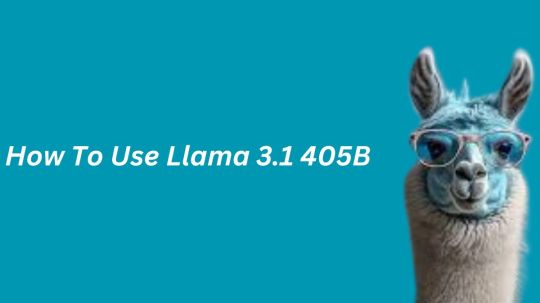
How to set up and use large open models for multi-host generation AI over GKE
Access to open models is more important than ever for developers as generative AI grows rapidly due to developments in LLMs (Large Language Models). Open models are pre-trained foundational LLMs that are accessible to the general population. Data scientists, machine learning engineers, and application developers already have easy access to open models through platforms like Hugging Face, Kaggle, and Google Cloud’s Vertex AI.
How to use Llama 3.1 405B
Google is announcing today the ability to install and run open models like Llama 3.1 405B FP16 LLM over GKE (Google Kubernetes Engine), as some of these models demand robust infrastructure and deployment capabilities. With 405 billion parameters, Llama 3.1, published by Meta, shows notable gains in general knowledge, reasoning skills, and coding ability. To store and compute 405 billion parameters at FP (floating point) 16 precision, the model needs more than 750GB of GPU RAM for inference. The difficulty of deploying and serving such big models is lessened by the GKE method discussed in this article.
Customer Experience
You may locate the Llama 3.1 LLM as a Google Cloud customer by selecting the Llama 3.1 model tile in Vertex AI Model Garden.
Once the deploy button has been clicked, you can choose the Llama 3.1 405B FP16 model and select GKE.Image credit to Google Cloud
The automatically generated Kubernetes yaml and comprehensive deployment and serving instructions for Llama 3.1 405B FP16 are available on this page.
Deployment and servicing multiple hosts
Llama 3.1 405B FP16 LLM has significant deployment and service problems and demands over 750 GB of GPU memory. The total memory needs are influenced by a number of parameters, including the memory used by model weights, longer sequence length support, and KV (Key-Value) cache storage. Eight H100 Nvidia GPUs with 80 GB of HBM (High-Bandwidth Memory) apiece make up the A3 virtual machines, which are currently the most potent GPU option available on the Google Cloud platform. The only practical way to provide LLMs such as the FP16 Llama 3.1 405B model is to install and serve them across several hosts. To deploy over GKE, Google employs LeaderWorkerSet with Ray and vLLM.
LeaderWorkerSet
A deployment API called LeaderWorkerSet (LWS) was created especially to meet the workload demands of multi-host inference. It makes it easier to shard and run the model across numerous devices on numerous nodes. Built as a Kubernetes deployment API, LWS is compatible with both GPUs and TPUs and is independent of accelerators and the cloud. As shown here, LWS uses the upstream StatefulSet API as its core building piece.
A collection of pods is controlled as a single unit under the LWS architecture. Every pod in this group is given a distinct index between 0 and n-1, with the pod with number 0 being identified as the group leader. Every pod that is part of the group is created simultaneously and has the same lifecycle. At the group level, LWS makes rollout and rolling upgrades easier. For rolling updates, scaling, and mapping to a certain topology for placement, each group is treated as a single unit.
Each group’s upgrade procedure is carried out as a single, cohesive entity, guaranteeing that every pod in the group receives an update at the same time. While topology-aware placement is optional, it is acceptable for all pods in the same group to co-locate in the same topology. With optional all-or-nothing restart support, the group is also handled as a single entity when addressing failures. When enabled, if one pod in the group fails or if one container within any of the pods is restarted, all of the pods in the group will be recreated.
In the LWS framework, a group including a single leader and a group of workers is referred to as a replica. Two templates are supported by LWS: one for the workers and one for the leader. By offering a scale endpoint for HPA, LWS makes it possible to dynamically scale the number of replicas.
Deploying multiple hosts using vLLM and LWS
vLLM is a well-known open source model server that uses pipeline and tensor parallelism to provide multi-node multi-GPU inference. Using Megatron-LM’s tensor parallel technique, vLLM facilitates distributed tensor parallelism. With Ray for multi-node inferencing, vLLM controls the distributed runtime for pipeline parallelism.
By dividing the model horizontally across several GPUs, tensor parallelism makes the tensor parallel size equal to the number of GPUs at each node. It is crucial to remember that this method requires quick network connectivity between the GPUs.
However, pipeline parallelism does not require continuous connection between GPUs and divides the model vertically per layer. This usually equates to the quantity of nodes used for multi-host serving.
In order to support the complete Llama 3.1 405B FP16 paradigm, several parallelism techniques must be combined. To meet the model’s 750 GB memory requirement, two A3 nodes with eight H100 GPUs each will have a combined memory capacity of 1280 GB. Along with supporting lengthy context lengths, this setup will supply the buffer memory required for the key-value (KV) cache. The pipeline parallel size is set to two for this LWS deployment, while the tensor parallel size is set to eight.
In brief
We discussed in this blog how LWS provides you with the necessary features for multi-host serving. This method maximizes price-to-performance ratios and can also be used with smaller models, such as the Llama 3.1 405B FP8, on more affordable devices. Check out its Github to learn more and make direct contributions to LWS, which is open-sourced and has a vibrant community.
You can visit Vertex AI Model Garden to deploy and serve open models via managed Vertex AI backends or GKE DIY (Do It Yourself) clusters, as the Google Cloud Platform assists clients in embracing a gen AI workload. Multi-host deployment and serving is one example of how it aims to provide a flawless customer experience.
Read more on Govindhtech.com
#Llama3.1#Llama#LLM#GoogleKubernetes#GKE#405BFP16LLM#AI#GPU#vLLM#LWS#News#Technews#Technology#Technologynews#Technologytrends#govindhtech
2 notes
·
View notes
Text
SQLi Potential Mitigation Measures
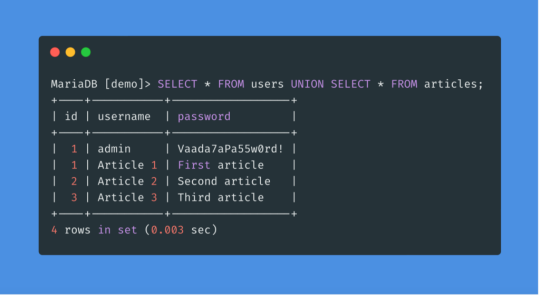
Phase: Architecture and Design
Strategy: Libraries or Frameworks
Use a vetted library or framework that prevents this weakness or makes it easier to avoid. For example, persistence layers like Hibernate or Enterprise Java Beans can offer protection against SQL injection when used correctly.
Phase: Architecture and Design
Strategy: Parameterization
Use structured mechanisms that enforce separation between data and code, such as prepared statements, parameterized queries, or stored procedures. Avoid constructing and executing query strings with "exec" to prevent SQL injection [REF-867].
Phases: Architecture and Design; Operation
Strategy: Environment Hardening
Run your code with the minimum privileges necessary for the task [REF-76]. Limit user privileges to prevent unauthorized access if an attack occurs, such as by ensuring database applications don’t run as an administrator.
Phase: Architecture and Design
Duplicate client-side security checks on the server to avoid CWE-602. Attackers can bypass client checks by altering values or removing checks entirely, making server-side validation essential.
Phase: Implementation
Strategy: Output Encoding
Avoid dynamically generating query strings, code, or commands that mix control and data. If unavoidable, use strict allowlists, escape/filter characters, and quote arguments to mitigate risks like SQL injection (CWE-88).
Phase: Implementation
Strategy: Input Validation
Assume all input is malicious. Use strict input validation with allowlists for specifications and reject non-conforming inputs. For SQL queries, limit characters based on parameter expectations for attack prevention.
Phase: Architecture and Design
Strategy: Enforcement by Conversion
For limited sets of acceptable inputs, map fixed values like numeric IDs to filenames or URLs, rejecting anything outside the known set.
Phase: Implementation
Ensure error messages reveal only necessary details, avoiding cryptic language or excessive information. Store sensitive error details in logs but be cautious with content visible to users to prevent revealing internal states.
Phase: Operation
Strategy: Firewall
Use an application firewall to detect attacks against weaknesses in cases where the code can’t be fixed. Firewalls offer defense in depth, though they may require customization and won’t cover all input vectors.
Phases: Operation; Implementation
Strategy: Environment Hardening
In PHP, avoid using register_globals to prevent weaknesses like CWE-95 and CWE-621. Avoid emulating this feature to reduce risks. source
3 notes
·
View notes
Text
SQL Temporary Table | Temp Table | Global vs Local Temp Table
Q01. What is a Temp Table or Temporary Table in SQL? Q02. Is a duplicate Temp Table name allowed? Q03. Can a Temp Table be used for SELECT INTO or INSERT EXEC statement? Q04. What are the different ways to create a Temp Table in SQL? Q05. What is the difference between Local and Global Temporary Table in SQL? Q06. What is the storage location for the Temp Tables? Q07. What is the difference between a Temp Table and a Derived Table in SQL? Q08. What is the difference between a Temp Table and a Common Table Expression in SQL? Q09. How many Temp Tables can be created with the same name? Q10. How many users or who can access the Temp Tables? Q11. Can you create an Index and Constraints on the Temp Table? Q12. Can you apply Foreign Key constraints to a temporary table? Q13. Can you use the Temp Table before declaring it? Q14. Can you use the Temp Table in the User-Defined Function (UDF)? Q15. If you perform an Insert, Update, or delete operation on the Temp Table, does it also affect the underlying base table? Q16. Can you TRUNCATE the temp table? Q17. Can you insert the IDENTITY Column value in the temp table? Can you reset the IDENTITY Column of the temp table? Q18. Is it mandatory to drop the Temp Tables after use? How can you drop the temp table in a stored procedure that returns data from the temp table itself? Q19. Can you create a new temp table with the same name after dropping the temp table within a stored procedure? Q20. Is there any transaction log created for the operations performed on the Temp Table? Q21. Can you use explicit transactions on the Temp Table? Does the Temp Table hold a lock? Does a temp table create Magic Tables? Q22. Can a trigger access the temp tables? Q23. Can you access a temp table created by a stored procedure in the same connection after executing the stored procedure? Q24. Can a nested stored procedure access the temp table created by the parent stored procedure? Q25. Can you ALTER the temp table? Can you partition a temp table? Q26. Which collation will be used in the case of Temp Table, the database on which it is executing, or temp DB? What is a collation conflict error and how you can resolve it? Q27. What is a Contained Database? How does it affect the Temp Table in SQL? Q28. Can you create a column with user-defined data types (UDDT) in the temp table? Q29. How many concurrent users can access a stored procedure that uses a temp table? Q30. Can you pass a temp table to the stored procedure as a parameter?
#sqlinterview#sqltemptable#sqltemporarytable#sqltemtableinterview#techpointinterview#techpointfundamentals#techpointfunda#techpoint#techpointblog
4 notes
·
View notes
Text
Choosing the Right Top Drive System Components: A Buyer's Guide
There is no overemphasising the role of a functioning top drive system in the world of drilling. This is because it is necessary for you to learn more about the main parts of top drive systems, which are critical in making drilling operations optimal. The aim of this buyer’s guide, therefore, is to unravel the selection procedure, taking into account the efficiency and performance aspects.
Top Drive System Drilling – Understanding the Basics
Some basics about the top drives and top drive system drilling before diving into the various drilling components. This advanced technology has changed the face of the drilling industry, making it possible to create a new approach to drilling the well bore. Unlike top drive systems, the traditional ones necessitate stopping and pulling out the whole drill string each time they occur, leading to lesser efficiency and productivity.
Key Components for Optimal Performance
a. Powerful Motors:
Motors dominate in any top drive. Effective rotation of the drill string is possible with high-powered electric hydraulic motors. For this reason, the motor should be very powerful as it ensures smoother drilling.
b. Pipe Handling System:
Because of this, the process should be smooth; hence, a dependable pipe-handling system is important. It is made up of components that are intended to handle a pipe connection or drills. Choose a system that can cater for various pipe sizes and loads for flexibility.
c. Top Drive Control System:
Its brain is the control organ that operates the whole drilling process. Drilling parameters should be easy to read for the operator during drilling. The control program determines how safe, efficient and well-conceived a drilling operation will be.
Important Considerations for the Best Top Drive System Components
a. Compatibility:
Ensure that your equipment has spare parts of the top drive system for your purchase. There could be operational problems or even shutdowns when using the wrong parts. Ensure that there is compliance with the specifications and ease of integration with the supplier.
b. Durability:
Utilise strong objects that will be able to deal with the extreme stresses of a drilling environment. Employing this type of top-quality parts enhances the longevity of your top drive system at a much lesser cost and shorter time.
c. Ease of Maintenance:
User-friendliness also includes ease of maintenance. Choose items that are simple to look at, replace, and store.- This minimises downtime and hence ensures maximum productivity for your drilling operation.
Importance of Regular Maintenance
Still, however, purchasing the most efficient drive system is just one of the things that are done. Periodic maintenance should be done for efficiency in running the equipment and longevity services. Create an extensive preventive maintenance schedule and observe it accordingly. This process is made smooth by periodic inspection, lubrication, and replacement of worn-out parts.
Conclusion: Elevating Your Drilling Operations
Hence, it is important to understand the main parameters which are necessary to be successful at drilling in the selection of the proper top drive system parts. Drill operations must target high-powered motors, pipe handling systems and modern control systems.
However, it should be remembered that the performance of these elements relies not only on their selection at the beginning but also on the permanent maintenance of these elements in the subsequent production phases. Consequently, ensure high efficiency of the top drive system in order to achieve maximum production rates and minimise downtimes. Having this buyer’s guide will help you select appropriately so as to improve your drilling activities.
2 notes
·
View notes
Text
Get the Finest Precision with CNC Machining
In a subtractive manufacturing technique known as CNC machining, materials are precisely shaped and cut into the necessary shapes. CNC machining automates the production process in contrast to conventional machining, which mainly depends on manual intervention, leading to improved precision, repeatability, and efficiency.
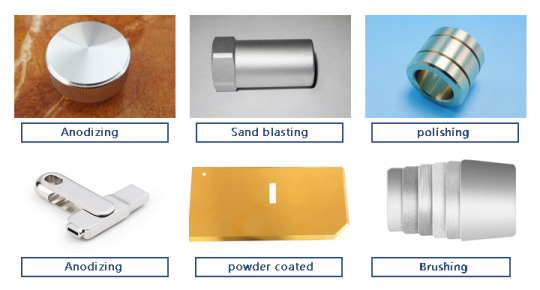
Using computer-aided design (CAD) software, a digital design is produced at the start of the process. The design acts as a guide for how the CNC machine should operate. The design is then transformed into a machine-readable format, often a G-code program, which gives instructions for the CNC machine after it is complete.
The ultimate product's needs are taken into consideration while selecting the material, which may be made of metals, polymers, or composites. By sawing the material into the required sizes, either manually or automatically, the material is prepared.
The prepared material is firmly secured to the work table of the CNC machine. The CNC program is entered into the machine's controller once the cutting tools, such as drills, mills, or lathes, are mounted during the CNC machining process.
After the machine is configured, the CNC controller reads the G-code program and gives precise instructions to the machine's motors to move the cutting tools. The cutting tools execute operations including drilling, milling, turning, and more to remove material in line with the design parameters.
Throughout the machining process, quality control procedures are used to make sure that the part's dimensions, tolerances, and surface finishes adhere to the necessary standards. To check accuracy, you could use measurement equipment like calipers, micrometers, or coordinate measuring machines (CMMs).
The advantages of CNC machining
The excellent precision and accuracy of CNC machining is well known. The process is computer-controlled, which guarantees consistent and dependable outcomes, making it perfect for applications that call for precise tolerances and complex geometries.
CNC machines can deal with a variety of materials, such as composites, metals, plastics, and wood. This adaptability makes it possible to produce a variety of components for different businesses.
Complex items may be produced fast and effectively using CNC machining. Once set up, the device can run alone with little assistance from a person. This shortens the production process and increases output in general.
It is possible to produce identical components with great repeatability using CNC prototype machining. Manufacturers can reliably make huge numbers of components because of the CNC program's ability to be stored and used again.
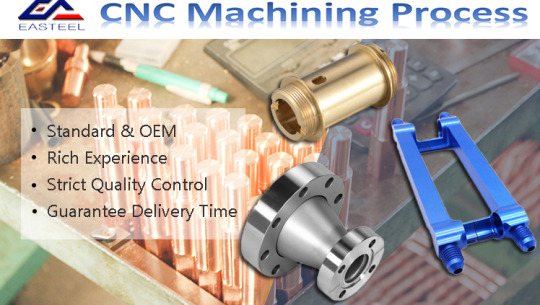
Main source: https://cneasteel.wordpress.com/
#CNC Machining#CNC Machining process#CNC Machining Techniques#CNC Prototype Machining#CNC Machining China
2 notes
·
View notes
Text
How to choose the best payment gateway in UAE?
Picking the correct payment gateway is basic to encourage the payment procedure of any online store. This arrangement permits traders to have full power over the payment stream while improving the specialized association with card acquirers. In any case, there are numerous arrangements out there. In view of this, we have prepared a concise manual for help online retailers pick the best choice for their stores.
What is a Payment Gateway?
A payment gateway is a specialized solution that permits online stores to process payments. It comprises of a back-end administration that associates the online shop with card acquirers, safely moving the payment data between them. It fundamentally fills in as what could be compared to the POS machines. Shippers build up a legally binding relationship and get the funds collected directly from the card acquirers.
The most effective method to choose a Payment Gateway
There are a few focuses that ought to be considered while thinking about an payment portal. To encourage the way toward choosing, we have arranged a rundown with the most applicable focuses dealers should remember:
Similarity: A significant point is to check if an payment portal is perfect with an online store e- commerce platform. This ought to be the primary thing to be completed, as there is no reason for checking everything else if a payment passage can’t be incorporated with an online store except if dealers are happy to move their stores to an alternate stage.
Reconciliation: A great payment portal ought to be anything but difficult to coordinate into any web condition. It ought to be good with shop frameworks or programming language and give consistent coordination. Card acquirers regularly change their mix parameters, which powers dealers with immediate acquirer coordination to modify their innovation incorporation. Then again, a payment portal ought to tackle this issue for vendors by adjusting its foundation to the acquirers’ changes, furnishing on the web organizations with a steady and reliable integration
Security: The payment business has severe security norms that a payment portal should be consistent with. Vendors must ensure that the picked passage follows all measures, particularly PCI DSS, a standard made by Visa and Mastercard that guarantees that the paymeny door is secure to store charge card subtleties. By having an exclusive stage, the gateway can rapidly adjust to dealers’ and market needs. In like manner, it likewise appreciates greater security as there are no outsiders with access to its framework and greater adaptability to make, test and improve inventive solutions
Compromise: Ideally, a payment gateway ought to give a progression of extra assets, for example, business insight with reports and redid diagrams for a superior comprehension of the whole business activity.
Usefulness: The payment gateway ought to give fundamental and propelled functionalities, for example, a single tick and repeating payments, which help improve the payment experience, just as pre-approval, that can purchase shippers some an opportunity to run extra hazard examination, fractional catch and multi-acquirer reattempt.
Extortion anticipation: A Payment gayeway itself doesn’t filter any payment transaction; however it ought to be good and incorporated with misrepresentation counteraction arrangements. Some gateway suppliers will have their exclusive devices and others will be coordinated with outsider enemy of extortion services, which permits dealers to include the administration without the requirement for extra specialized usage
Direct checkout: Choosing a payment gateway that can be utilized behind the shipper’s own checkout page gives traders higher transformation rates. This happens for the most part since purchasers feel a more noteworthy suspicion that all is well and good when they don’t need to leave the stores’ sites to finish the payment, what’s more, to abstain from adding another progression to the checkout procedure.
Backing: Another pertinent point is technical support. Shippers should ensure an payment door is prepared to furnish them with quick and skillful technical support.
Expenses: Usually, there is a setup fee that dealers must compensation before executing the payment gateway platform. The payment passages for the most part charge expenses per exchange created, for both finished and bombed exchanges. The expenses apply to payment, discount and chargeback exchanges. Costs alone shouldn’t be a deciding element. We emphatically suggest dissecting the various focuses too to pick the payment portal that best suits an internet business needs.
It is important that the utilization of a payment gateway is regularly a superior option for shippers with bigger deals volumes as it permits them to decrease their general expenses. A gateway setup requires an organization to have a specific structure to deal with all the legally binding connections and procedures. Thusly, if a business comes up short on this structure, a payment processor offering collection services, where the payment processor holds any agreements with card acquirers and is liable for moving the cash gathered to the dealers may very well be the best alternative. On the off chance that shippers despite everything need to have certain authority over payments, picking a supplier that offers a half breed model can be the solution.
Foloosi Technology, a payment gateway UAE brings to you easy to use options that are designed to be accessible, convenient and simple backed by reputed partners to provide security and a credible and reliable customer experience.
For Android:
For iOS :
Foloosi Technology, online payment gateway UAE provides a convenient way for a user to make in – store payments and can be used at business listed with the Foloosi Technology service provider.
Foloosi was founded in 2018 and launched its product in the year 2019 that enables simple and easy way to accept and process payment solution for businesses.
Foloosi introduced a new feature, Pickup and Delivery which helps both the merchants and their customers
Log in to the merchant panel; add products with its description which is now listed in the business section of customer app.
Customers can view the product, once they ordered; a message box will be displayed asking the customers to select pick- up/ delivery. When they select the delivery option, they will be taken to the page to add their address. Once it is done payment is processed including the shipping fee to the Foloosi merchant
Now the merchant can deliver the product to their customers at their doorstep.
This new feature of Foloosi helps UAE merchants to reach their products at every nook and corners of UAE. They can sell their products not only in metropolitan areas, but also in pastoral areas
click here to know more - https://foloosi.com/payment-gateway-in-uae
#payment gateway#best payment gateway in UAE#fintech solution#payment method#best payment gateway in dubai
0 notes
Text
Working with stored procedures in ADO.NET? I’ve put together a practical, hands-on guide featuring six essential retrieval techniques, real-world C# code examples, and a ready-to-use SQL Server database for testing. ✅ Output parameters, return values, DataReaders, DataTables, and more! ✅ Full-featured console application to test the methods in action ✅ Clear, structured explanations to enhance your database skills
0 notes
Text
How UAE’s Accredited Laboratories Leverage Automation for Precision Testing? | +971 554747210
The UAE is rapidly advancing as a regional hub for scientific research, manufacturing, and quality assurance. At the heart of this progress are accredited laboratories in the UAE, which play a vital role in ensuring products and materials meet stringent standards. To stay ahead in a competitive global market, many of these labs are embracing automation technologies that revolutionize precision testing.
Automation is transforming how accredited laboratories operate, enabling faster, more accurate, and highly reliable test results. This blog explores how UAE’s accredited laboratories leverage automation for precision testing, the benefits of automation, and its impact on various industries.
The Growing Importance of Accredited Laboratories in the UAE
Laboratory accreditation, such as ISO/IEC 17025 certification granted by bodies like ENAS (Emirates National Accreditation System), guarantees that labs meet international quality and technical standards. These accredited labs are trusted to deliver reliable testing services essential for:
Regulatory compliance
Product certification
Quality assurance
Research and development
In sectors like oil and gas, pharmaceuticals, food safety, and manufacturing, precision testing is non-negotiable. Automation helps UAE’s accredited laboratories meet these high demands efficiently and consistently.
What Is Automation in Laboratory Testing?
Automation in laboratory testing involves using technology-driven systems, robotics, and software to perform test procedures with minimal human intervention. This includes:
Automated sample preparation and handling
Robotic liquid handling systems
Computer-controlled analytical instruments
Integrated data acquisition and management platforms
By reducing manual processes, automation minimizes human error, speeds up workflows, and enhances data accuracy.
How UAE’s Accredited Laboratories Use Automation for Precision Testing
1. Automated Sample Preparation
Sample preparation is often the most labor-intensive and error-prone part of testing. UAE labs use automated systems to:
Weigh and measure samples precisely
Perform dilution and mixing with exact proportions
Conduct sample digestion or extraction processes
Automation ensures uniformity across samples, which is critical for reproducible test results.
2. Robotic Liquid Handling
Accredited labs in the UAE implement robotic liquid handlers to transfer precise volumes of liquids during chemical analysis, molecular biology, and pharmaceutical testing. These robots offer:
High throughput processing
Reduced contamination risks
Consistent pipetting accuracy
This technology is vital for labs conducting food safety tests, water quality analysis, and drug potency assays.
3. Advanced Analytical Instruments
Automation extends to advanced instruments such as:
Chromatography systems (GC, HPLC) for separating chemical mixtures
Spectroscopy devices (UV-Vis, FTIR, Mass Spectrometry) for qualitative and quantitative analysis
Automated microscopes and imaging systems for material characterization
These instruments are often integrated with software that controls their operation, collects data, and processes results automatically.
4. Data Management and Reporting
Automated data management platforms collect, store, and analyze test data securely. Features include:
Real-time data monitoring
Automated calculation of results with statistical validation
Generation of standardized, customizable reports
Traceability and audit trails for compliance
Such platforms help UAE’s accredited laboratories maintain transparency and meet regulatory demands efficiently.
Benefits of Automation for UAE’s Accredited Laboratories
Enhanced Accuracy and Precision
Automation drastically reduces human error associated with manual handling and subjective interpretation. Precise control over sample volumes, instrument parameters, and data processing leads to more consistent and trustworthy results.
Increased Testing Throughput
Automated systems can process hundreds or thousands of samples simultaneously, dramatically increasing laboratory productivity. This is crucial in sectors like food testing or environmental monitoring where large sample volumes are routine.
Faster Turnaround Time
Automation shortens testing cycles, enabling faster delivery of results without compromising quality. This agility helps manufacturers and exporters meet tight deadlines and regulatory timelines.
Improved Safety
Handling hazardous chemicals and biological samples manually poses risks. Automated systems reduce operator exposure to dangerous substances, promoting safer laboratory environments.
Regulatory Compliance and Traceability
Automation supports compliance with international standards such as ISO/IEC 17025 by maintaining comprehensive records, reducing documentation errors, and facilitating external audits.
Impact of Automation on Key UAE Industries
Oil and Gas
Accredited labs use automated precision testing to analyze petroleum products, pipeline materials, and environmental samples. Rapid and accurate test results help companies comply with local and global standards, ensuring operational safety and efficiency.
Pharmaceuticals
Automation in pharmaceutical testing ensures drug quality, potency, and purity. Accredited labs in the UAE employ robotic systems for sample prep and automated instrumentation to meet stringent health authority requirements.
Food Safety
The UAE’s food import and manufacturing sectors depend heavily on accredited labs to test for contaminants, allergens, and nutritional content. Automation enables high-throughput screening of food samples, essential for consumer safety.
Manufacturing and Construction
Material testing labs use automated systems to assess the mechanical, chemical, and physical properties of metals, plastics, and composites. This ensures that products meet UAE’s regulatory and quality benchmarks.
Challenges and Considerations in Implementing Automation
Despite its advantages, automation implementation requires significant investment in equipment, staff training, and software integration. Accredited laboratories must:
Select compatible automated systems for their specific testing needs
Maintain rigorous calibration and validation of automated instruments
Ensure skilled personnel are trained to operate and troubleshoot automated workflows
UAE laboratories are increasingly partnering with global technology providers and investing in workforce development to overcome these challenges.
The Future of Automation in UAE’s Accredited Laboratories
With the UAE’s strategic focus on innovation and smart technologies, automation in accredited laboratories is poised for exponential growth. Emerging trends include:
Artificial Intelligence (AI) and Machine Learning: For predictive analytics and anomaly detection in test data
Internet of Things (IoT): Connected devices providing real-time monitoring of laboratory instruments
Cloud-based Data Solutions: Enhancing collaboration, storage, and remote access to lab results
Advanced Robotics: For fully autonomous lab workflows
These advancements will further improve the precision, efficiency, and scalability of testing services offered by accredited laboratories in the UAE.
Conclusion
Automation is revolutionizing the landscape of accredited laboratories in the UAE, especially in delivering precision testing critical to multiple industries. By integrating robotic systems, advanced instruments, and sophisticated data management platforms, UAE’s labs achieve unparalleled accuracy, faster throughput, and enhanced safety.
For businesses seeking reliable testing and certification, partnering with an ENAS-accredited, ISO/IEC 17025 certified laboratory that leverages automation is a smart move. It ensures compliance, quality, and operational excellence in today’s fast-paced market.
As the UAE continues to lead in technology adoption, the future of laboratory testing will undoubtedly be shaped by intelligent automation — empowering accredited labs to set new standards of precision and trust.
0 notes
Text
Tap Density Tester-TD-101
TAP DENSE TD - 101 is a density measurement equipment used to measure tapped density of powders, as well as granulated or flaked materials by standardized and repeatable procedures. Instrument uses the latest microprocessor technology and advanced engineering techniques so as to give enhanced accuracy a reproducibility. System is equipped with 4-line alphanumeric LCD display with backlit and 16 number of soft touch membrane type keys. The unit is provided with two motorized platforms which allow for 14 ÷ 2.0 mm drop height for the USP Method I version, and a 3 ÷0.3 mm drop height for the USP Method Il version. The motorized platforms consist of two-cylinder holders with snap-lock mechanism designed to hold 100 ml and 250 ml cylinders. The simultaneous rotating and tapping motion minimizes any possible loss of mass during tapping down. The instrument stores the test parameters, readings and results simultaneously in the memory which are retained even after the power is switched OFF. Provision has also been made for attachment of a printer so as to provide hard-copy printouts of test data, including the time, date and calculated results.
SALIENT FEATURES:
Extremely useful for pharmaceutical labs
Microprocessor based, easy to use
20 x 4 line alphanumeric LCD display with backlit
16 Soft touch membrane type keys
Tap Density, Initial Density, Compressibility Index
Independent programmable setups for User & USP mode with storage
RS232 Printer attachment facility
Automatically calculates result parameters like Hausner Ratio
Automatically stores last result
Power failure detection facility
User-friendly operation with menus & current status indicators
visit www.technvovale.in for more info.
#TechnovalueSolutions#TechnovalueInstruments#MadeForLabs#AdvancedLabTech#SmartLabSolutions#LabAutomationTools#PrecisionInstruments#TapDenseTD101
0 notes
Text
Remediation of SQLi
Defense Option 1: Prepared Statements (with Parameterized Queries)
Prepared statements ensure that an attacker is not able to change the intent of a query, even if SQL commands are inserted by an attacker. In the safe example below, if an attacker were to enter the userID of tom' or '1'='1, the parameterized query would not be vulnerable and would instead look for a username which literally matched the entire string tom' or '1'='1.
Defense Option 2: Stored Procedures
The difference between prepared statements and stored procedures is that the SQL code for a stored procedure is defined and stored in the database itself, and then called from the application.
Both of these techniques have the same effectiveness in preventing SQL injection so it is reasonable to choose which approach makes the most sense for you. Stored procedures are not always safe from SQL injection. However, certain standard stored procedure programming constructs have the same effect as the use of parameterized queries when implemented safely (the stored procedure does not include any unsafe dynamic SQL generation) which is the norm for most stored procedure languages.
Defense Option 3: Allow-List Input Validation
Various parts of SQL queries aren't legal locations for the use of bind variables, such as the names of tables or columns, and the sort order indicator (ASC or DESC). In such situations, input validation or query redesign is the most appropriate defense. For the names of tables or columns, ideally those values come from the code, and not from user parameters.
But if user parameter values are used to make different for table names and column names, then the parameter values should be mapped to the legal/expected table or column names to make sure unvalidated user input doesn't end up in the query. Please note, this is a symptom of poor design and a full rewrite should be considered if time allows.
Defense Option 4: Escaping All User-Supplied Input
This technique should only be used as a last resort, when none of the above are feasible. Input validation is probably a better choice as this methodology is frail compared to other defenses and we cannot guarantee it will prevent all SQL Injection in all situations.
This technique is to escape user input before putting it in a query and usually only recommended to retrofit legacy code when implementing input validation isn't cost effective.
3 notes
·
View notes
Text
Hardness Tester- TEST-301
Hardness Tester- TEST-301Measuring tablet thickness, diameter and hardness the PHARMAG INSTRUMENTS TabTest-301 Tablet Hardness Tester is both USP and EP compliant and offers excellent flexibility and configurability. This robust 301 design removes the need for a thickness gauge, eliminating redundant calibrations and reducing overall testing cost.
Product Features:
USP PHARMACOPEIA AND EP COMPLIANT: Compliant with USP < 1217> and EP <2.9.8>.
MULTI-PARAMETER MEASUREMENTS: The TabTest -301 measures:
Thickness
Diameter
Hardness
LED DISPLAY: The seven-segment display provides calibration, thickness, diameter, and hardness results.
SMALL FOOTPRINT: Ideal for laboratories with limited bench space. The compact, lightweight design is well-suited for portability and use in a production setting.
"OPTIONAL" BUILT-IN PRINTER: Available with an optional 40-column built-in printer.
SAMPLE THROUGHPUT: Approximately 6-10 samples per minute.
"ADJUSTMENT FREE" TESTING JAWS: No adjustments needed for the test jaws. They are designed to suit all tablet shapes and sizes with a unique grooved design to properly align each tablet before testing.
Specifications:
Display: LED
Keypad: User-friendly 9-key operations
Hardness Range: 5 - 500 N
Hardness Accuracy: >1 N
Diameter and Thickness Range: 1.5 - 40 mm
Diameter Accuracy: >±0.06 mm
Measurements: Thickness and diameter in either mm or inches
Measurable Units:
N (Newton)
KP (KiloPond, 1 KP = 9.81 N)
Sc (Strong Cobb, 1 KP = 1.435 c)
Force Rate Constant (Linear): Force or constant (linear) speed
Number of Tests for Statistics: Up to 99
Stored Methods: Last test result
Calibration Procedure: Requires 10 mm Reference Block and 10 kg Reference Weight (Certified)
Calibration Technique: No tilt (user-friendly)
Distance Validation: 10 mm Certified Block (For Thickness and Diameter)
Load Cell Linearity: 3-Point Linear Calibration with Certified Weight (5, 10, 15 kg)
Load Cell Diagnostic Check: Yes (Check the Load Cell Signal Falls Within Range Before Making Any Further Calibration)
Self Test: Yes
Fault Localization: Yes (Text Format)
Load Cell Overload Protection: Yes
Password Protection: Yes (For Advance Settings)
Factory Setting Reset: Yes
Real-Time Clock: Yes
No Tablet Detection: Yes
Interface Ports:
RS-232 (Serial Port for Service Use Only)
External 80/40 Column Printer
40 Column Built-In Mini Dot Matrix Printer
Dimensions: 235 (L) x 420 (B) x 195 (H) mm
Weight: 16.5 lbs / (7.5 kg)
Electrical Power:
115V ± 15V, 50/60 Hz or
230V ± 23V, 50/60 Hz visit www.technovalue.in for more information
#TabletHardnessTester#TabTest301#HardnessTesting#TabletTesting#PharmaInstruments#TabletMeasurement#ThicknessTesting#DiameterMeasurement#USPCompliant#EPCompliant#PharmaCompliance#RegulatoryTesting#CostEffectiveTesting#NoRedundantCalibration#LabAutomation#SmartPharmaTesting#PrecisionTesting#TestingEfficiency#PharmaceuticalTesting#LabEquipment#PharmaceuticalLab#QualityControl#PharmaTech
0 notes
Text
youtube
Dynamic Data Sorting in SQ L( Dynamic Order By Clause in SQL)
How can you sort the data based on the parameterized column names in SQL?
How can you write a stored procedure that accepts column name as input parameter and returns data sorted based on the the provided column?
Please subscribe to the channel for more videos like this: https://www.youtube.com/c/TechPointFundamentals?sub_confirmation=1
#sqlinterviewquestionsandanswers#interviewquestionsandanswers#sqlinterview#techpointfundamentals#techpointfunda#techpoint#Youtube
3 notes
·
View notes
Text
Mystery Audits India – Elevating Business Standards Across Sectors
In today’s hyper-competitive market, customer satisfaction is the key to brand loyalty and sustained growth. Companies across India are constantly searching for ways to improve their customer service, store standards, and employee performance. One of the most effective and unbiased ways to do this is through Mystery Audits India. But what exactly are these audits, and why are they so crucial for your business?

What are Mystery Audits India?
Mystery audits, also known as secret shopper programs, are anonymous evaluations conducted by trained individuals posing as regular customers. Their job is to observe, interact, and assess various aspects of a business such as staff behavior, cleanliness, adherence to standard operating procedures (SOPs), product availability, and overall customer service experience.
With Mystery Audits India, businesses can gain real-time feedback from the ground level, enabling them to identify service gaps, employee training needs, and areas of improvement. These audits provide objective insights that are often difficult to gather through traditional internal reviews or customer surveys.
Why Mystery Audits India are Essential for Businesses
India’s diverse customer base and evolving market demands have made it necessary for brands to maintain high standards consistently. Here’s why Mystery Audits India play a vital role:
Unbiased Customer Experience Feedback Mystery audits give businesses a candid look at the real-time customer experience without any filters.
Compliance Monitoring They help ensure that SOPs, safety protocols, and brand guidelines are being followed diligently across locations.
Training and Performance Evaluation Mystery audit reports highlight areas where staff training may be required, thereby improving service delivery.
Brand Consistency Whether it's a retail chain or a restaurant franchise, audits ensure that each outlet maintains the brand’s promise to customers.
Industries Leveraging Mystery Audits India
The scope of Mystery Audits India is vast and spans across several industries:
1. Retail Mystery Audits India
Retail stores rely heavily on foot traffic and customer satisfaction. Mystery audits help evaluate factors such as:
Staff courtesy and knowledge
Store layout and cleanliness
Stock availability
Billing experience
A well-executed retail audit can enhance customer retention and drive more conversions.
2. Hospitality Mystery Audits India
Hotels and restaurants need to offer top-notch service to attract and retain guests. Mystery audits in hospitality cover:
Reservation experience
Food quality and presentation
Ambience and cleanliness
Staff interaction and promptness
Such audits are critical in maintaining service excellence and boosting online reviews.
3. Banking and Financial Mystery Audits India
In the BFSI sector, customer trust and efficient service are non-negotiable. Mystery audits assess:
Queue management and waiting time
Staff behavior and knowledge of products
Branch infrastructure
Adherence to compliance norms
These audits help banks ensure regulatory compliance and customer-centric services.
4. Automotive Mystery Audits India
For automotive brands, both sales and service centers need to uphold certain standards. Mystery audits check:
Product knowledge during inquiry
Test drive experience
After-sales service quality
Timely communication and follow-ups
Such insights help companies improve their sales funnel and post-sale satisfaction.
How CTRL Services is Redefining Mystery Audits India
At CTRL Services, we specialize in customized Mystery Audits India that are tailored to your business model and industry-specific requirements. Our team of experienced auditors uses a data-driven approach to deliver actionable insights that can transform customer experience and operational efficiency.
Our Mystery Audit India Process Includes:
Audit Design and Customization We define clear audit parameters based on your business objectives.
Trained Mystery Shoppers Our shoppers are trained to identify service gaps and provide detailed, unbiased reports.
Real-Time Reporting Our digital dashboards allow you to monitor results, trends, and compliance in real-time.
Feedback Loop and Recommendations We don’t just point out issues — we suggest improvements for long-term success.
Whether you run a single outlet or a nationwide chain, our comprehensive mystery audit solutions help you stay ahead in the game.
Benefits of Partnering with CTRL Services for Mystery Audits India
Choosing CTRL Services for Mystery Audits India comes with several advantages:
Pan-India audit network
Industry-specific audit modules
Scalable solutions for all business sizes
Confidentiality and professionalism
In-depth reports with actionable insights
We take pride in being one of India’s most reliable partners when it comes to enhancing service quality and brand performance through mystery audits.
Future of Mystery Audits India – A Data-Driven Evolution
With increasing digitization, Mystery Audits India are evolving. Real-time analytics, AI-based reporting tools, and mobile audit apps are making audits quicker, more accurate, and incredibly insightful.
As consumer expectations rise and competition intensifies, mystery audits will not just remain a quality check tool but will become a strategic business necessity. Businesses that invest in regular mystery audits today are likely to be the market leaders of tomorrow.
Ready to Transform Your Customer Experience?
If you're serious about improving your service quality, customer satisfaction, and operational efficiency, it's time to embrace the power of Mystery Audits India. At CTRL Services, we’re committed to helping businesses like yours achieve excellence through professional and data-backed audits.
📞 Contact us today to schedule your first audit. 📧 Email us at [email protected] 🌐 Visit https://ctrlservice.in/
🔍 Discover the difference that only Mystery Audits India can make – with CTRL Services by your side.
0 notes
Text
How to Maintain Hygiene in a Bottled Water Plant
In today’s fast-paced world, where access to clean drinking water is becoming increasingly important, the demand for bottled water continues to rise.
But with this growing demand comes a major responsibility—hygiene.

Whether you operate a packaged drinking water plant or a mineral water plant, maintaining high standards of hygiene is not just a legal requirement, it's a moral obligation to the health and safety of your customers.
Clean water can turn into a health hazard if the bottling process is not hygienically maintained.
Consumers trust your mineral water bottle for purity—so that’s exactly what you need to deliver every time.
In this blog, we'll break down the essential practices, tips, and guidelines to ensure your bottled water plant stays hygienic and safe.
1. Understand the Importance of Hygiene in Bottled Water Production
Let’s start with why hygiene matters so much.
Contaminated water, even after treatment, can become a source of illness if it's bottled or stored in unsanitary conditions.
Pathogens, bacteria, and chemical residues can infiltrate at any point—whether through unclean machinery, poor handling, or improper storage.
Maintaining hygiene not only ensures public safety but also protects your brand reputation and prevents expensive recalls or penalties from regulatory bodies.
2. Facility Design and Infrastructure
A hygienic plant starts with proper design. Here’s what to keep in mind:
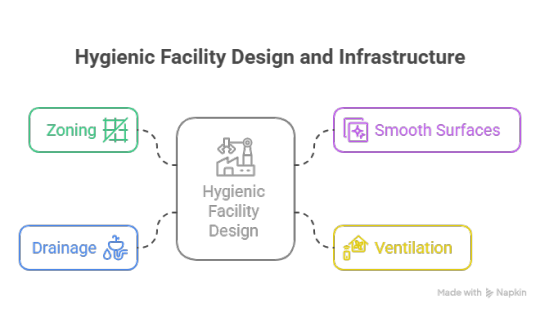
Zoning:
Divide the facility into clean and non-clean areas. Water treatment and bottle filling zones must be strictly restricted.
Smooth Surfaces:
Walls and floors should be made of non-porous, easy-to-clean materials. Avoid cracks where mold or bacteria can grow.
Ventilation:
Install proper air filtration systems to avoid airborne contaminants.
Drainage:
Water should flow away from production areas. Poor drainage is a major hygiene hazard.
Pro Tip: If you’re consulting a mineral water plant manufacturer, ensure they help you design a layout that supports sanitary flow—from raw water entry to bottled product exit.
3. Equipment Sanitation
All machinery—whether it’s for RO purification, UV disinfection, or ozone dosing—must be regularly cleaned and sanitized.
Regular Cleaning Schedules:
Create a Standard Operating Procedure (SOP) for cleaning each machine. Whether it’s the bottle washer, filler, capper, or labelling unit, each piece must be cleaned daily or weekly depending on usage.
Use Food-Grade Cleaners:
Avoid industrial chemicals that may leave residues. Use only certified, food-grade sanitizing solutions.
Maintenance Logs:
Keep a documented log of every cleaning and maintenance task for audits and compliance checks.
4. Staff Hygiene and Training
People are one of the most common sources of contamination in any production environment.
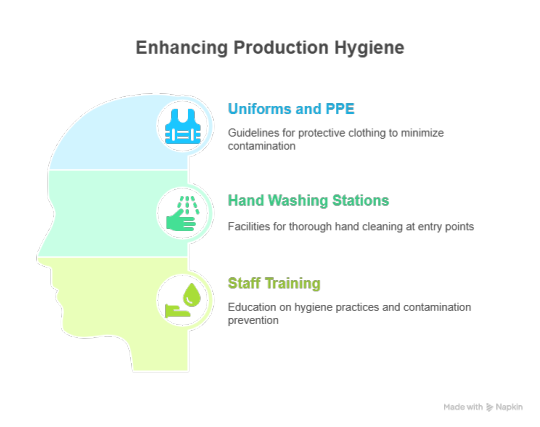
Uniforms and PPE:
Employees must wear clean uniforms, gloves, masks, and hairnets. Footwear should be exclusive to the production zone.
Hand washing Stations:
Install hand washing units at all entry points. Include soap, hand sanitizer, and disposable towels.
Staff Training:
Train your employees on personal hygiene, cross-contamination prevention, and equipment handling. Refresher sessions every 3-6 months are ideal.
Remember: In any mineral water plant, staff plays a crucial role in maintaining cleanliness. Empower them with knowledge.
5. Water Source and Pre-Treatment
Before even entering the bottling line, your raw water must go through stringent checks.
Source Quality:
Whether it’s borewell, municipal, or spring water, test the source regularly for chemical and biological contamination.
Laboratory Testing:
A well-equipped in-house lab or partnership with an accredited third-party lab can ensure water parameters are consistently within safe limits.
Filtration and Disinfection:
Use multi-stage purification methods: sand filter, carbon filter, RO (reverse osmosis), UV, and ozone. This not only enhances taste and purity but also meets BIS standards.
6. Bottle and Cap Hygiene
Often overlooked, bottles and caps can be a major source of contamination if not handled correctly.

Bottle Washing:
Whether you're using PET or glass, each bottle must be thoroughly cleaned before filling. Automatic rinsing machines using treated water and sanitizing agents are ideal.
Cap Sterilization:
Caps can carry microbes, especially if stored improperly. Use UV sterilizers or chemical sanitizers before capping the bottle.
Storage of Empty Containers:
Store bottles and caps in a dust-free, insect-proof room.
7. Filling and Packaging
This is where the product is most vulnerable. One small lapse can contaminate the entire batch.
Clean Room Environment:
Bottle filling areas must be sealed and maintained as sterile zones. Use laminar airflow cabinets if possible.
Automated Systems:
Minimize manual handling during filling, capping, and labeling to reduce contamination risk.
Temperature Control:
Maintain a cool and dry environment. High temperatures can breed bacteria, especially in sealed containers.
8. Pest Control and Waste Management
Uncontrolled waste and pests can destroy even the best hygiene practices.
Pest Control:
Implement regular pest control treatments through certified agencies. Keep detailed records.
Waste Segregation:
Separate recyclable, biodegradable, and hazardous waste. Ensure timely disposal of sludge, rejected water, and used filters.
Clean Environment:
Don’t just clean machines—clean floors, walls, storage racks, and air vents too.
9. Compliance with Government Regulations
In India, every mineral water plant must comply with BIS (Bureau of Indian Standards) norms and FSSAI (Food Safety and Standards Authority of India) regulations.
Regular Inspections:
Schedule internal audits and be ready for surprise inspections from regulatory bodies.
Maintain Documentation:
Keep records of water tests, batch production, cleaning logs, staff training, and pest control for at least a year.
10. Quality Assurance and Final Testing
After bottling, before sending it to the market, test your water again.
Microbiological Testing:
Ensure no pathogens like E. coli, Salmonella, or coliforms are present.
Final Approval:
Send samples from each batch to an external lab for validation.
Storage Before Dispatch:
Keep finished bottles in a cool, dry, and dust-free storage room. Avoid direct sunlight.
Conclusion
Maintaining hygiene in a bottled water plant isn’t just about compliance—it’s about protecting your brand, your customers, and your peace of mind.
From sourcing water to delivering the final mineral water bottle to the end user, every step should reflect your commitment to quality.
Partnering with a reliable mineral water plant manufacturer can make this easier. The right supplier will not only help you with top-grade machinery but also guide you on plant layout, hygiene protocols, and compliance.
By following the best practices shared above, you can ensure that every bottle that rolls off your production line is a symbol of trust, purity, and care.
Are you planning to set up a new mineral water plant or upgrade your existing one?
Let's discuss how you can implement hygienic systems that are efficient and regulation-ready.
#mineral water plant#mineral water plant manufacturer#water bottle filling machine#mineral water filling machine#packaged mineral water#water bottle making machine
0 notes